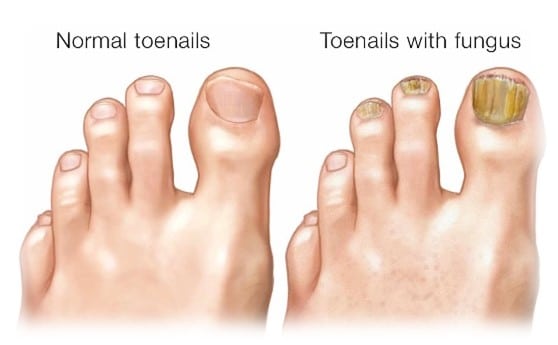Onychomycosis and Toenail Fungus Treatment
Thickened, discolored nails, often harboring debris and foul odors, are a source of great embarrassment for those suffering from foot and toenail fungus. Over half of all nail infections which are treated by medical specialists are due to fungi (Del Rosso, 2014). If you are among the millions of people who suffer from fungus nail infections, do not be embarrassed or ashamed. Help is surely here!
But first, let’s talk about toenail fungus!
What does onychomycosis mean?
Well, fungal infections may affect any part of the body. Fungi are normally present in and on the body alongside various bacteria. But when a fungus begins to overgrow, that’s when you can get an infection.
Onychomycosis (pronounced: on-ih-koh-my-KOH-sis), also called tinea unguium, is an infection that affects the finger- and toenails when fungi get between the nail and the nail bed (tissue beneath the nail). Fungi grow best in the presence of moisture, poor air circulation, and warmth. Toenails provide the perfect growing conditions for microbial growth to occur. Even if you are diligent, wear loose fitting shoes or socks, spend most of your life in sandals, and dry your hands and feet carefully; the infection may still occur and seemingly out of nowhere.
Having a nail infection doesn’t necessarily imply that your hygiene is lacking as everyone is susceptible to contracting a nail infection. And fungal infections normally develop over time, so any immediate difference in the way your nail looks or feels may be too subtle to notice at first.

Fortunately, there are steps which you can take to decrease the likelihood of your nails becoming infected. If you learn to recognize early signs of a fungal infection, you will be able to begin treatment promptly. The sooner that you start to treat the fungus, the less invasive it will become, and the easier it will be to cure.
The Signs of Fungus Nail Infection
A toe and nail fungus infection may initially appear as small, white streaks or discoloration and the nail may appear dull-looking or have and unusually rough surface. As time progresses, other symptoms may include:
- Further discoloration of the nail (which may become chalky, darken, and turn yellow or brown)
- White spots, streaks, or ridges on the nail surface
- Foul odor coming from the infected area
- Thickening of the nail
- Separating of the nail from the nail bed
- Cracking or breaking of the nail in one or more spots
- Debris that collects under the nail
 It is vital that you to seek treatment for fungal infections as soon as they appear, since they are capable of rapidly invading other nails and tissue. Early treatment reduces overall disfiguration of the nails, prevents embarrassment, and causes less discomfort.
It is vital that you to seek treatment for fungal infections as soon as they appear, since they are capable of rapidly invading other nails and tissue. Early treatment reduces overall disfiguration of the nails, prevents embarrassment, and causes less discomfort.
NOTE: Many types of toenail fungi are quite contagious. An infected person may spread the fungus to someone else through direct contact. You can also get toenail fungus by touching an infected surface.
Susceptibility to Toenail Fungus
Anyone may get toenail fungus; however, it often affects older adults, especially people over the age of 60.
You may have a higher risk of getting foot nail fungus if you have pre-existing conditions, like:
- Athlete’s foot
- Diabetes
- Nail injury
- Poor blood circulation due to peripheral vascular disease
- Psoriasis
- Hyperhidrosis (disorder that makes you sweat excessively)
- Weakened immune system, such as from an autoimmune disorder
Our Recommendations to Prevent Toenail Fungus
While there is no way to guarantee that you won’t get toenail fungus, there are several steps you could take to help prevent it:
- Avoid going barefoot in communal areas such as hotel rooms / showers, public showers, locker rooms and swimming pools. It helps to wear flip flops in these public areas.
- If you have a family member with foot fungus or nail fungus, try to use different shower or wear flip flops in the shower to avoid coming in contact with it.
- Trauma due to accidental or aggressive clipping of the nails can turn into portals of entry for the fungus.
- Clean your nail trimmer before using it.
- Do not tear or rip your toenails on purpose.
- If you have diabetes, follow all foot care recommendations from your healthcare provider.
- Ensure to fully dry your feet after a shower or bathing.
- Soak toenails in warm water before cutting them. Or trim your nails after a warm shower or bath.
- Trim toenails straight across, instead of rounding the edges deep into the skin in the corners.
- Wear shoes that fit properly. Shoes should not be too loose or pinching the toes.
So, you’ve realized you have toenail fungus, now what?
How To Get Rid Of Toenail Fungus
We offer the ClearSteps Onychomycosis Treatment. ClearSteps is a revolutionary treatment for toenail fungus onychomycosis in a patient- friendly, quick, and effective way with Nd:YAG laser light.
Most Effective Treatment For Toenail Fungus
Laser light deeply penetrates the nail, evenly heating (at an appropriate temperature) throughout the depth of infected nail and skin tissue, effectively weakening, and killing parasitic fungi which have infected the patient’s nail. The natural growth and immune processes of the body are then able to restore the nail to its pristine state. Compared to traditional methods the effects of laser light spread evenly throughout the tissue and are not subject to either the limits of chemical diffusion, as are topicals, or the induction of hepatoxic side effects, as is the case with oral medications.
Toenail Fungus Treatment Procedures:
The laser treatment for toenail fungus can be performed in three simple steps:

The guest completes the first step! Prior to your appointment, please file down the overgrown nail. This is in order to fully penetrate into the infected site. It is important to know that during onychomycosis, the infected nail will become deformed and overgrown and may also thicken.
 Nd:YAG laser pulses are administered in a circular pattern, slightly overlapping the beam so that the nail is fully covered. It is important to know that a slight heating sensation will be felt throughout the nail.
Nd:YAG laser pulses are administered in a circular pattern, slightly overlapping the beam so that the nail is fully covered. It is important to know that a slight heating sensation will be felt throughout the nail.
 Nd:YAG laser pulses are targeted around the perimeter of the nail bed and infection site. Often, parasitic fungus has worked its way beyond the nail bed and needs to be eliminated in all the tissue surrounding the nail to prevent recurrence.
Nd:YAG laser pulses are targeted around the perimeter of the nail bed and infection site. Often, parasitic fungus has worked its way beyond the nail bed and needs to be eliminated in all the tissue surrounding the nail to prevent recurrence.
The treatment is usually performed 4 – 6 times, at one-week intervals. All of the nails will be treated, during every treatment (just in case).
Post-Treatment
We recommend our R3 Derma Health Pro Organic Aloe Vera Gel.
The Results: Healthy Nails!
In as little as 15 minutes, you could be on the way to enjoying healthy, aesthetically pleasing nails without the dangerous side-effects associated with anti-fungal drugs.

Advantages Of Laser Treatment For Toenail Fungus:
- Complete fungal elimination
- Non-invasive so zero downtime
- No chemicals or oral medication
- Stimulates the natural growth and immune processes of the body
- Extremely fast and easy to perform
- Safe and patient-friendly treatment with no dangerous side effects
- Unsurpassed treatment success rate compared to traditional methods

We sincerely hope that this article has helped you to understand that toenail fungus is nothing to be ashamed of and that there is a cure.
FAQS
1. What is onychomycosis of toenails?
Onychomycosis is a fungal infection affecting the toenails. It occurs when fungi get between the nail and the nail bed, leading to thickened, discolored, and sometimes foul-smelling nails.
2. What does toenail fungus look like?
Toenail fungus may start as small white spots or streaks on the nail. As the infection progresses, the nail can become yellow or brown, thickened, and brittle, with debris collecting under the nail.
3. Can toenail fungus be painful?
Yes, toenail fungus can become painful, especially as the nail thickens, causing discomfort or pressure on the toe. Advanced infections can also lead to a foul odor and difficulty walking.
4. Can toenail fungus heal on its own?
Toenail fungus rarely heals on its own. Without treatment, it often worsens over time and can spread to other nails and surrounding skin.
5. How does toenail fungus spread?
Toenail fungus spreads through direct contact with infected surfaces or people. It’s commonly spread in communal areas like public showers, locker rooms, and pools.
6. Can onychomycosis be cured?
Yes, onychomycosis can be cured with proper treatment, such as laser therapy, which effectively eliminates the fungal infection without harmful side effects.
7. How can I treat toenail fungus?
Toenail fungus can be treated with methods like laser treatment, which deeply penetrates the nail to kill the fungus, or with topical or oral medications, though these may have side effects.
8. What are the signs of toenail fungus?
Early signs include white spots or discoloration. As it progresses, the nail may thicken, darken, and develop ridges or a foul odor.
9. What are the advantages of laser treatment for toenail fungus?
Laser treatment is non-invasive, doesn’t require chemicals or oral medications, and has no harmful side effects. It also promotes natural nail regrowth.
10. How long does it take to see results from laser treatment for toenail fungus?
Healthy nail growth may begin in a few weeks, but full restoration can take several months, depending on nail growth rate.
LET US HELP YOU PUT THE SPRING BACK IN YOUR STEP!
Our friendly and qualified staff are here to give you any recommendation, with utmost passion for skincare. Contact us for pricing and if you have any further questions or wish to book an appointment, simply call us at (604) 696-5506 or book a consultation.
Post-Treatment Recommendations
Our favorite treatments and products to help maintain post-treatment results:
We recommend our R3 Derma Pro Organic Aloe Vera Gel and R3 Derma Pro Exfoliating Cream Cleanser.
Social Media
Related Articles
Featured Services
Acne Treatment
Get clearer, brighter acne free skin. We can painlessly destroy bacteria that causes acne and heal scar tissue.
Facial Hair Removal
Say goodbye to embarrassing fuzz! Permanently remove unwanted facial hair on any skin type or hair color with laser treatments.
Microdermabrasion
Microdermabrasion gently rejuvenates the skin by non-invasive exfoliation.







